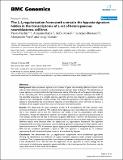The l[subscript 1]-l[subscript 2] regularization framework unmasks the hypoxia signature hidden in the transcriptome of a set of heterogeneous neuroblastoma cell lines
Author(s)
Varesio, Luigi; Verri, Alessandro; Mosci, Sofia; Barla, Annalisa; Fardin, Paolo; Rosasco, Lorenzo Andrea; ... Show more Show less
DownloadFardin-2009-The l(1)-l(2) regula.pdf (1.652Mb)
PUBLISHER_CC
Publisher with Creative Commons License
Creative Commons Attribution
Alternative title
The l1-l2 regularization framework unmasks the hypoxia signature hidden in the transcriptome of a set of heterogeneous neuroblastoma cell lines
Terms of use
Metadata
Show full item recordAbstract
Background: Gene expression signatures are clusters of genes discriminating different statuses of the cells and their definition is critical for understanding the molecular bases of diseases. The identification of a gene signature is complicated by the high dimensional nature of the data and by the genetic heterogeneity of the responding cells. The l[subscript 1]-l[subscript 2] regularization is an embedded feature selection technique that fulfills all the desirable properties of a variable selection algorithm and has the potential to generate a specific signature even in biologically complex settings. We studied the application of this algorithm to detect the signature characterizing the transcriptional response of neuroblastoma tumor cell lines to hypoxia, a condition of low oxygen tension that occurs in the tumor microenvironment.
Results: We determined the gene expression profile of 9 neuroblastoma cell lines cultured under normoxic and hypoxic conditions. We studied a heterogeneous set of neuroblastoma cell lines to mimic the in vivo situation and to test the robustness and validity of the l[subscript 1]-l[subscript 2] regularization with double optimization. Analysis by hierarchical, spectral, and k-means clustering or supervised approach based on t-test analysis divided the cell lines on the bases of genetic differences. However, the disturbance of this strong transcriptional response completely masked the detection of the more subtle response to hypoxia. Different results were obtained when we applied the l[subscript 1]-l[subscript 2] regularization framework. The algorithm distinguished the normoxic and hypoxic statuses defining signatures comprising 3 to 38 probesets, with a leave-one-out error of 17%. A consensus hypoxia signature was established setting the frequency score at 50% and the correlation parameter ε equal to 100. This signature is composed by 11 probesets representing 8 well characterized genes known to be modulated by hypoxia.
Conclusion: We demonstrate that l[subscript 1]-l[subscript 2] regularization outperforms more conventional approaches allowing the identification and definition of a gene expression signature under complex experimental conditions. The l[subscript 1]-l[subscript 2] regularization and the cross validation generates an unbiased and objective output with a low classification error. We feel that the application of this algorithm to tumor biology will be instrumental to analyze gene expression signatures hidden in the transcriptome that, like hypoxia, may be major determinant of the course of the disease.
Date issued
2009-10Department
Massachusetts Institute of Technology. Center for Biological & Computational Learning; McGovern Institute for Brain Research at MITJournal
BMC Genomics
Publisher
BioMed Central
Citation
Fardin, Paolo et al. “The l1-l2 regularization framework unmasks the hypoxia signature hidden in the transcriptome of a set of heterogeneous neuroblastoma cell lines.” BMC Genomics 10.1 (2009): 474.
Version: Final published version
ISSN
1471-2164